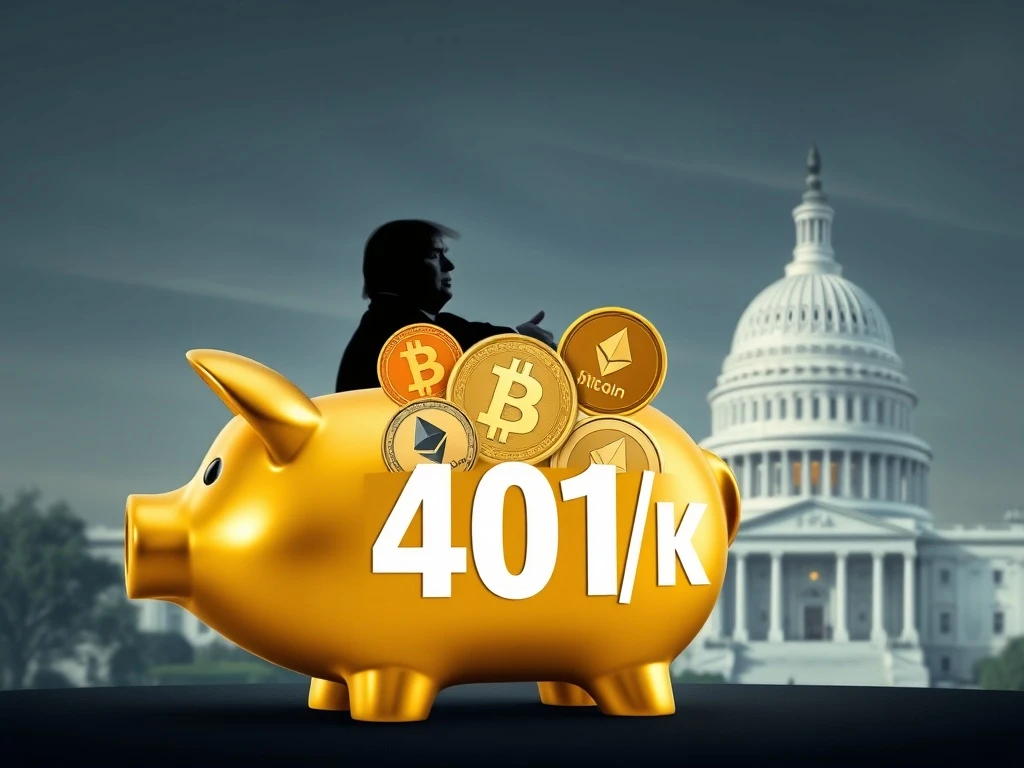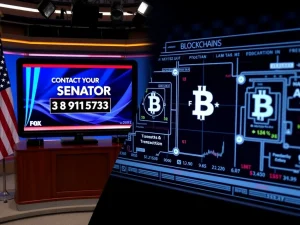Trump Crypto 401k: Executive Order Could Unlock Billions for Digital Assets

Imagine a future where your retirement savings, diligently built over years, aren’t just limited to traditional stocks and bonds but can also tap into the dynamic world of digital assets. This isn’t a distant dream; it’s potentially on the horizon. Recent reports suggest that Donald Trump is considering an executive order that could profoundly impact how Americans plan for their golden years, specifically by opening up 401(k) retirement funds to cryptocurrency investments. This move could be a significant step towards mainstream adoption, transforming the financial landscape for millions.
Trump Crypto 401k: A Potential Game Changer for Retirement Savings
The financial world is abuzz with news that former US President Donald Trump may sign an executive order aimed at broadening the investment options available within American 401(k) retirement plans. According to the Financial Times, citing sources briefed on the plans, this order could be enacted as early as this week. The core idea is to permit 401(k) plans to invest in alternative assets beyond the conventional stocks and bonds, including a broad spectrum of options such as digital assets, precious metals, and even funds focused on infrastructure, corporate takeovers, and private loans.
This executive order would not immediately greenlight crypto investments across all 401(k)s. Instead, it would direct Washington’s regulatory bodies to examine the most effective pathways for these plans to incorporate crypto, while also identifying and addressing any existing obstacles. This signals a proactive approach from the highest levels of government to explore the integration of digital currencies into established financial frameworks.
What Does This Mean for Your Retirement Funds?
The potential for retirement funds crypto inclusion marks a pivotal moment for investors. For years, 401(k) plans, which held a staggering $8.9 trillion in assets as of September 30, 2024, have largely confined their investments to mutual funds, exchange-traded funds, stocks, and bonds. This new directive could change that, offering a diversified portfolio that potentially includes Bitcoin and other digital assets.
However, it’s important to note the nuance. White House spokesman Kush Desai stated that while President Trump is dedicated to enhancing economic prosperity for Americans, “No decisions should be deemed official, however, unless they come from President Trump himself.” This underscores that while the discussions are serious, the final word rests with the former President.
Understanding the Shift: Why Retirement Funds Could Soon Invest in Crypto
The idea of allowing retirement funds crypto access is not entirely new. There’s a growing recognition of cryptocurrencies as a legitimate asset class, capable of significant returns. For instance, Bitcoin has outperformed the Nasdaq in annual returns for five out of the last six years, highlighting its potential as a growth vehicle. This performance, coupled with the desire for diversification, is driving interest from both policymakers and financial institutions.
Recent Regulatory and Industry Moves Supporting Crypto Investment:
- Labor Department Guidance: In a significant shift, the US Labor Department in May rescinded guidance issued during the Biden administration that had previously restricted the inclusion of cryptocurrency in 401(k) retirement plans. This removal of previous barriers indicates a more open stance from regulators.
- Fidelity’s Initiative: Financial services giant Fidelity, managing $5.9 trillion in assets, introduced a new retirement account in April, specifically allowing Americans to invest in crypto. This move by a major player demonstrates institutional confidence and paves the way for broader adoption.
- State-Level Exploration: Beyond federal discussions, individual states are also exploring crypto integration. North Carolina lawmakers, for example, introduced bills in March to permit the state’s treasurer to allocate up to 5% of various state retirement funds into cryptocurrencies like Bitcoin (BTC).
- International Precedent: The trend extends globally. Last November, UK-based pension specialist Cartwright reported an unnamed scheme making a 3% Bitcoin allocation to its pension fund. Japan’s Government Pension Investment Fund also considered Bitcoin as a diversification tool in March of the previous year.
These developments collectively point towards a growing acceptance and exploration of digital assets within traditional retirement savings vehicles.
Navigating the New Landscape: What This Means for 401k Plans
Should the executive order come to fruition, it would fundamentally alter the landscape for 401k plans. Employees could gain unprecedented access to an asset class previously out of reach within their employer-sponsored retirement accounts. This shift brings both exciting opportunities and important considerations.
Potential Benefits of Crypto in 401(k)s:
- Diversification: Adding cryptocurrencies can diversify a portfolio beyond traditional stocks and bonds, potentially reducing overall risk by spreading investments across different asset types.
- Growth Potential: Cryptocurrencies, particularly Bitcoin, have demonstrated high growth potential, offering a chance for significant returns that could boost retirement savings.
- Inflation Hedge: Some proponents view Bitcoin as a potential hedge against inflation, providing an alternative store of value in uncertain economic times.
- Accessibility: Integrating crypto into 401(k)s makes it easier for everyday Americans to gain exposure to digital assets without navigating complex exchanges or custody solutions independently.
Key Challenges and Considerations:
- Volatility: Cryptocurrencies are known for their price swings. While this offers high reward potential, it also carries higher risk, which might not suit all retirement savers.
- Regulatory Clarity: Despite recent shifts, the regulatory environment for crypto is still evolving. Future regulations could impact valuations and accessibility.
- Investor Education: Many individuals may not fully understand the complexities and risks associated with crypto. Comprehensive education will be crucial.
- Security Concerns: While 401(k) providers would likely handle custody securely, the digital nature of assets introduces unique security considerations compared to traditional investments.
Bitcoin Investment and Beyond: Opportunities and Safeguards
The focus often lands on Bitcoin investment due to its market dominance and historical performance, but the executive order could open doors to a broader range of digital assets. For individuals considering this new frontier, prudence is key. While the allure of high returns is strong, understanding one’s risk tolerance and long-term financial goals is paramount.
Actionable Insights for Retirement Savers:
- Stay Informed: Keep abreast of regulatory developments and announcements from the White House and relevant agencies.
- Assess Your Risk Tolerance: Before considering any crypto allocation, honestly evaluate your comfort level with market volatility and potential losses.
- Educate Yourself: Learn about the specific cryptocurrencies available, their underlying technology, and market dynamics.
- Consult a Financial Advisor: Seek professional guidance to understand how crypto might fit into your overall retirement strategy and to assess the tax implications.
- Start Small: If you decide to invest, consider a small, diversified allocation initially rather than a significant portion of your savings.
The potential for 401(k) plans to embrace digital assets represents a significant evolution in retirement planning. It signifies a growing acceptance of cryptocurrencies within mainstream finance and offers Americans new avenues for wealth creation. While the path forward will involve careful regulatory navigation and investor education, the prospect of unlocking billions in retirement funds for crypto investment is a development worth watching closely. It could redefine the future of financial security for a generation.










